Pawscessories is reader-supported. When you buy via links on our site, we may earn an affiliate commission at no cost to you.
Learn more.
Have you ever seen a Tri Color Bully? They are beautifully unique bulldogs, with a coat that sets them apart from the rest.
But what do you really know about them?
In this post, you’ll discover interesting facts about these dogs, including all their possible coat colors, how much each tri-coat variation costs, and much more!
So if you’re thinking about adding a Tri Color Bully to your family or simply interested in learning more about these rare dogs, read on.
Let’s jump right in.
Table of Contents
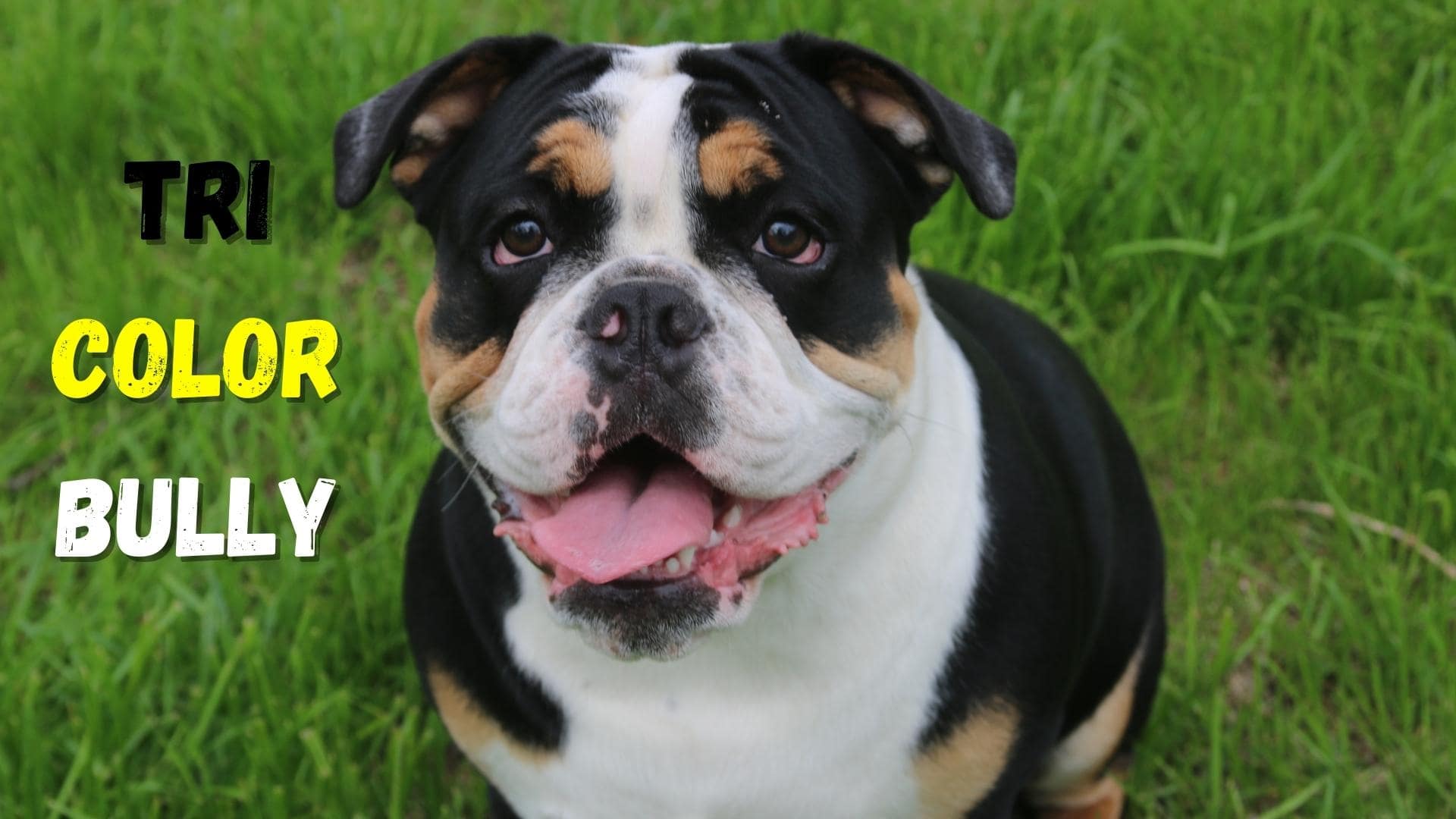
What Is a Tri Color Bully?
Put simply, a Tri Color Bully is an American Bulldog that has a coat with 3 distinctly different colors.
They can have any base color that is found in Bulldogs, whether it’s white, black, chocolate, lilac, cream, etc. Where they differentiate themselves is in their markings.
What’s also special is that the concentration of the color can vary based on their genes. Some will have more intense pigmentation, whereas others will have more diluted colors.
For example, a strong mahogany red versus lighter tan markings.
The reason these Bullies are so desirable is that most American Bulldogs have only 1 or 2 colors in their coats. It’s relatively uncommon to see a Bully with a Tri Coat.
Are Tri Color Bullies Rare?
Yes, the Tri Color Bully is quite rare. In fact, when compared to other Bully coat types, they are one of the rarest.
The reason for this is that the Tri Color Bully is the result of a recessive gene. This means that in order for a Bully to be Tri Color, both parents must carry the gene.
If only one parent carries the gene, the puppies will not be Tri Color.
In addition to this, for years, there was a misunderstanding about Tri Color Bullies which resulted in breeders actively trying to avoid producing them.
The misunderstanding was that they thought Tri Color Bullies were mixed breeds. And this was considered to be undesirable. Which means for several generations, the Tri Color Bully was avoided by many breeders.
So even though this misunderstanding has been corrected, as Tri Color Bullies are now known for being purebred, they are still challenging to find.
Also, different Tri Color Bulldogs have varying rarities. For example, since black is a very common coat color in Bulldogs, a Tri Color Bully with a black base is more common. As opposed to, say, a Tri Color Bully with a lilac base.
How Do You Get a Tri Color American Bully?
To better understand how a Tri Color Bully gets this coat variation, we have to understand how coat colors are determined in the first place.
All dog’s coat colors are determined by eumelanin and phaeomelanin.
Eumelanin is a black/brown pigment, and phaeomelanin is a red/yellow pigment.
All dogs have both of these pigments in their coat, but the ratio is what determines the final color.
And what controls this ratio is called the Agouti gene.
The Agouti gene essentially controls how much eumelanin and phaeomelanin are produced in a dog’s coat.
And this is what gives us all the different variations of coat colors that we see in dogs.
Now, a Tri Color Bully gets its coat color because it has a mutation in the Agouti gene. This is called the tan point gene.
The tan point gene is responsible for the markings you see on Tri Color Bullies.
These markings are typically found on the chest, face, legs, and under the tail.
And the way this gene works is that it suppresses the eumelanin pigment. So, for example, if a Bully has a black basecoat, the tan point gene will result in lighter brown markings.
In order for a Bully to be Tri Color, they must have two copies of the tan point gene. One from each parent.
If a Bully only has one copy of the tan point gene, they will not be Tri Color. Instead, they will just have the standard two colors in their coat.
So, in order to get a Tri Color Bully, you need to find two Bullies that both carry the tan point gene.
However, that doesn’t guarantee they will be born with a coat with 3 colors. This is because a Bully can carry the tan point genes from their parents but not express it in their coat color.
This is another reason why Tri Color Bullies are so rare.
7 Coat Variations Of The Tri Color Bully
Piebald Tri Color
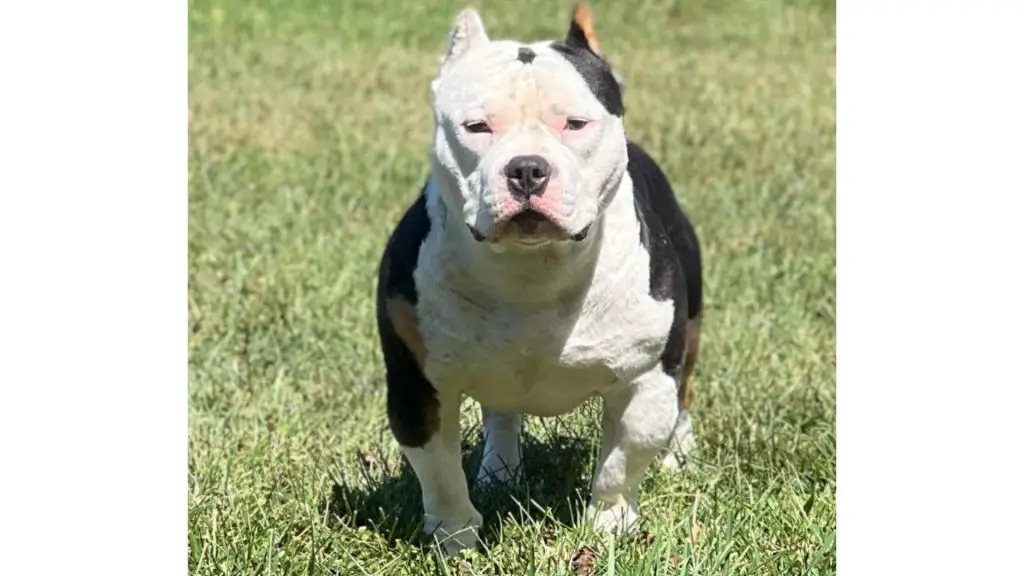
One of the most well-known Tri Color Bully coats is the Piebald. This coat variation is also sometimes called Pied.
The Piebald Tri Color Bully has a white base, with the rest of their coat having patches of two different colors. The two other colors can be any combination.
The most common combinations are black and tan/brown.
The amount of white on a Piebald Tri Color Bully can vary. Some may have more white than others. And the size of the patches can also differ.
Choco Tri Color
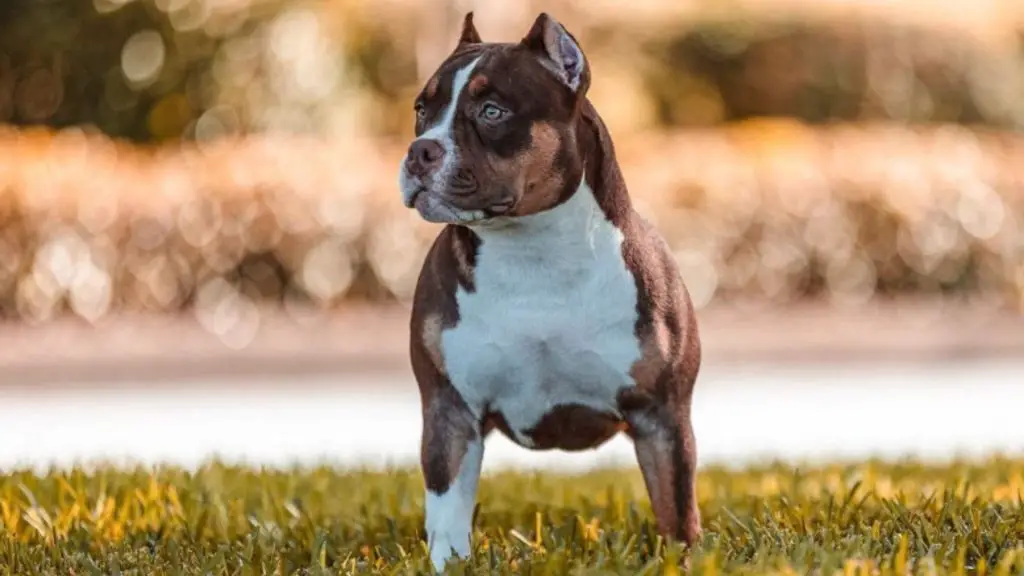
The Choco Tri Color Bully is very similar to the Piebald. The only difference is that they have a chocolate brown base instead of a white base.
And like the Piebald, the Choco Tri Color Bully will have patches of two other colors. The most common combination is white and tan/brown.
However, since the Choco Tri Color Bully has a chocolate brown base, the patches may be lighter in color.
Lilac Tri Color
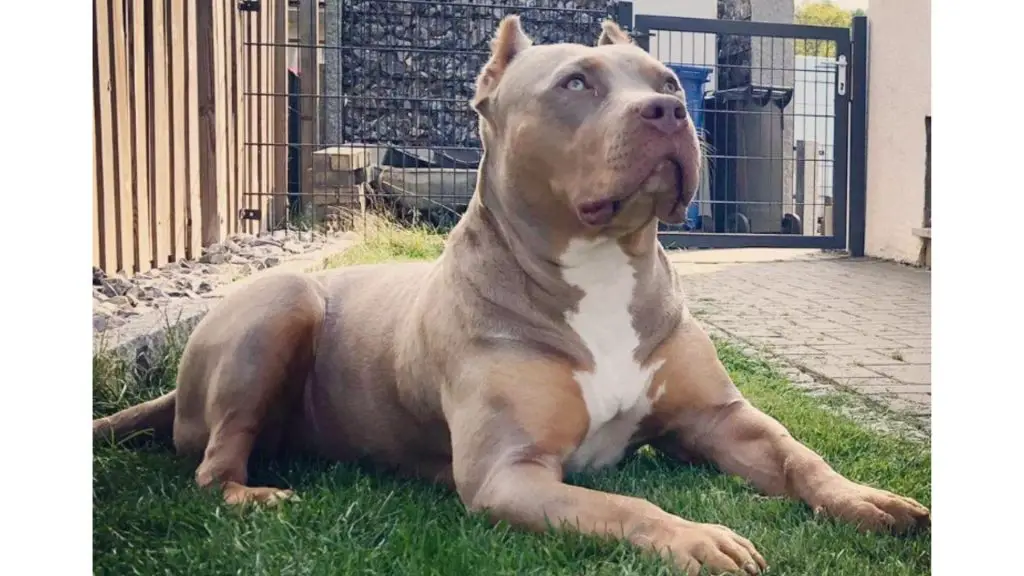
The Lilac Tri Color Bully is one of the rarer variations of the Tri Color Bully.
This coat variation is similar to the Choco Tri Color Bully and often misrepresented as a Choco Tri Color, but to the trained eye, they’ll notice their lighter base coat.
The Lilac Tri Color Bully has a lilac/purple base with patches of two other colors. The most common combinations are white and tan/brown.
Like the Choco Tri Color, the Lilac Tri Color Bully’s patches may be lighter in color due to their light base coat.
Black Tri Color
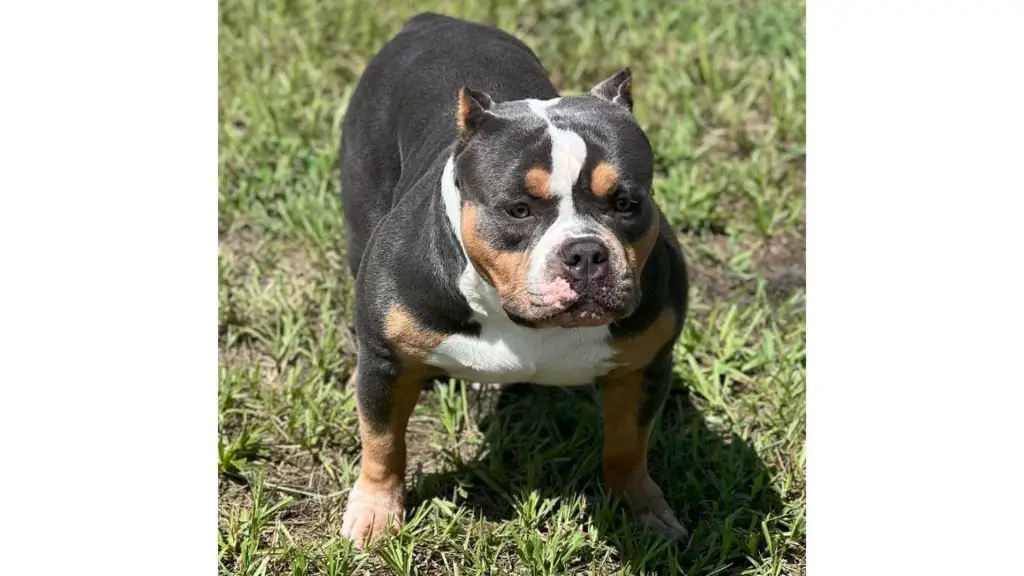
The Black Tri Color Bully is perhaps the most popular and well-known variation of the Tri Color Bully.
This coat variation is exactly what it sounds like. A black Tri Color Bully will have a black base with patches of two other colors. The most common combinations are white and tan/brown.
The Black Tri Color Bully is the most popular variation because their coat is very striking. The contrast of the black base with the lighter patches is really beautiful.
Blue Tri Color
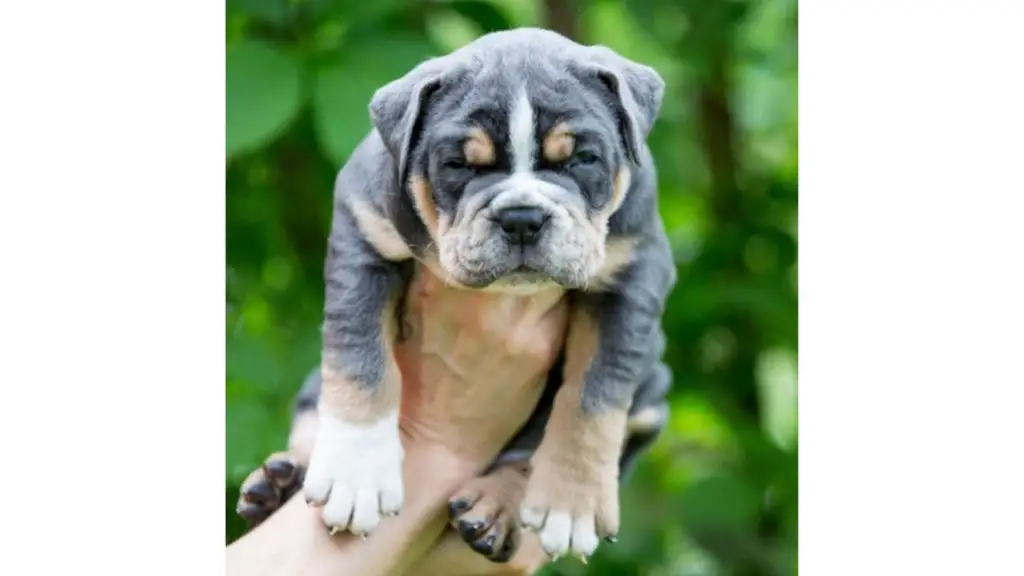
The blue Tri Color Bully is another rare variation of the Tri Color Bully.
A blue Tri Color Bully will have a blue/grey base with patches of white and tan/brown.
Like the Lilac Tri Color Bully, the blue Tri Color Bully is often misrepresented as a black Tri Color Bully. This is because the blue/gray base color is a dilution of black.
So people who don’t know a lot about dog coat color variations will often think it’s an off-black coat color.
Brindle Tri Color (AKA Trindle)

The Brindle Tri Color Bully, also sometimes called the Trindle, is a very unique looking Tri Color Bully.
This coat variation is similar to the Black Tri Color Bully in that they have a black base with patches of white and tan/brown.
However, what makes the Brindle Tri Color Bully unique is their coat pattern. Instead of having solid patches of color, their coat will have a brindle pattern.
This means their coat will be made up of stripes of color that give it a very unique look.
Ghost Tri Color
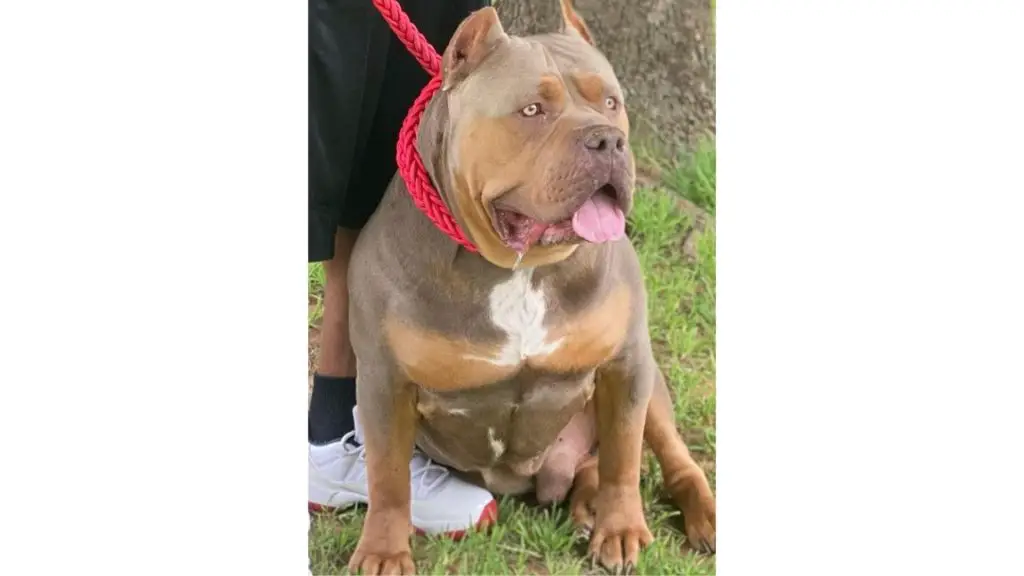
The Ghost Tri Color Bully is the rarest Tri Color Bully.
This coat variation is similar to the Lilac Tri Color Bully in that they have a light base coat. However, instead of being lilac/purple, their base coat is varying shades of brown.
As with all the other Tri Color Bully coats, they will have
How Much Is a Tri Color Bully?
The cost of a Tri Color Bully will depend on several factors. These include the breeder’s experience, the dog’s coat color and pattern, and whether the dog is pet quality or show quality.
Because the rarity and interests of each Tri Color Bully are different, each coat variation comes with a different price tag.
Generally, you can expect to pay anywhere from $4,000 to $15,000 for a Tri Color Bully.
Black Tri Colored Bullies cost anywhere between $6000 to $8000. Lilac Tri Colored Bullies are the most expensive, with a price tag sometimes as high as $15,000.
Unfortunately, if your heart is set on a Tri Color Bully, they come at a higher price.
However, if you simply love American Bulldogs and their coat color is less important, there are much more affordable single or two color-coated Bullies available.
Tri Color Bully Appearance & Traits
Size (Weight & Height)
Bulldogs come in a few different sizes, all of which are capable of being born with a Tri Colored coat.
The Standard Bulldog is the most common, weighing between 60-120 pounds. They’re also the tallest of the bunch, standing about 20-28 inches at the shoulder.
Miniature Bulldogs are less common, but they’re becoming more popular as people learn about them. They weigh between 30-50 pounds and stand about 12-18 inches tall.
Finally, there are what’s called the Rare or Exotic Bulldogs. These guys are the smallest of the bunch, weighing in at under 30 pounds. They’re also the shortest, standing at about 12 inches tall or less.
There is no real difference in temperament between the different sizes of Bullies. They’re all just as loving, loyal, and friendly as each other.
Coat Markings & Texture
The Tri Color Bully’s coat is their most defining feature. As the name suggests, they have a three-colored coat.
The base color is usually black, but it can also be blue, white, varying shades of brown, or lilac. They then have patches of white and tan or brown.
The coat is short and dense and very smooth to the touch. It’s also pretty easy to take care of, as it doesn’t require a lot of grooming.
Shedding & Grooming
All Bullies shed, and Tri Color Bullies don’t shed any more or less than any other color variation. They’re also pretty easy to groom, as their short coat doesn’t require a lot of upkeep.
A weekly brush will help remove any loose hair, and they’ll only need to be bathed every 8-12 weeks.
Their nails will also need to be trimmed on a regular basis, roughly once a month, and their teeth should be brushed at least once a week.
Are Tri Color Bullies Hypoallergenic?
No, Tri Color Bullies are not hypoallergenic. They do shed and have a tendency to drool.
So, if you’re looking for a hypoallergenic dog, the Tri Color Bully is not the best breed for you.
Ears & Tail
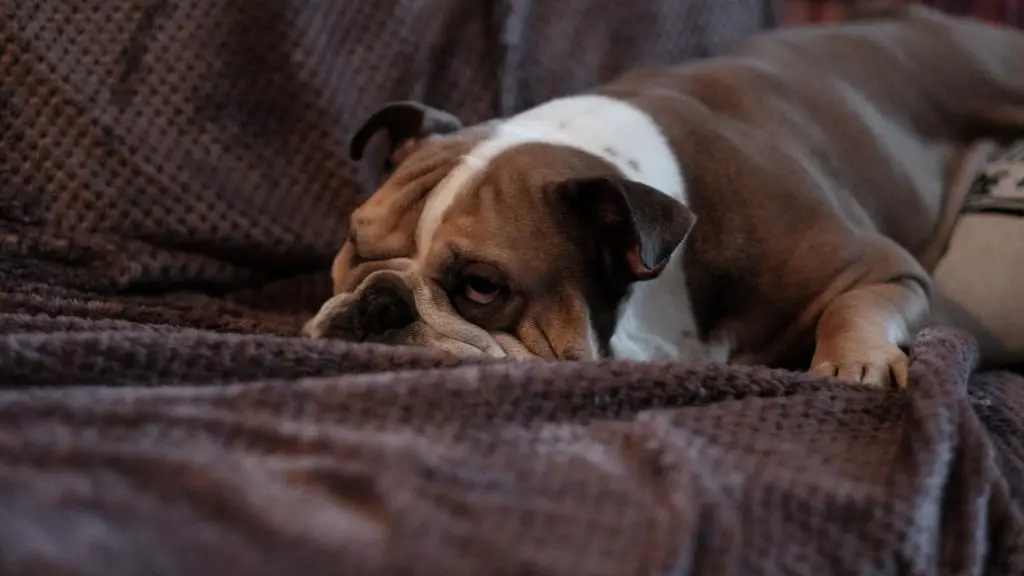
The Tri Color Bully has the same ears and tail as any other color variation of Bulldog.
They have small, triangular-shaped ears that sit high on their head and flop down beside their face. And they have a short, thick tail that’s usually straight and parallel with their body.
Eye Color
Tri Color Bullies can have any color of eyes, but the most common are brown and hazel. Blue and green eyes are also possible, but they’re more rare.
Lifespan
Tri Color Bullies have an average lifespan of about 11-12 years.
This is on par with the lifespan of most Bulldog breeds, and it’s slightly longer than the average lifespan for all dog breeds.
Common Health Issues
The Tri Color Bully is prone to the same health issues as any other Bulldog breed.
Some of the most common health concerns for Bullies include hip dysplasia, cherry eye, allergies, skin problems, and respiratory issues.
Hip dysplasia is a condition that occurs when the head of the thighbone does not fit snugly into the hip socket. This can cause pain and lameness and eventually lead to arthritis. Bulldogs are particularly prone to hip dysplasia because of their short legs and broad bodies.
Cherry eye is a condition caused by the prolapse of the third eyelid gland. This gland produces tears, which help keep the eye lubricated and protected from infection. When the gland prolapses, it becomes visible as a small, round mass near the inner corner of the eye. In some cases, cherry eye may resolve on its own, but in many cases, surgery is necessary to correct the problem.
Allergies are a common issue in Bulldogs, and they can be caused by anything from environmental allergies to food allergies. Bulldogs with allergies may have itchiness, redness, and swelling of the skin. They may also have runny eyes and nose, sneezing, and coughing.
Skin problems are also common in Bulldogs. This is because of their adorable skin folds. Without adequate maintenance and frequent cleaning of their folds, they may develop dry skin, rashes, hot spots, or other skin conditions. Bulldogs with skin problems may scratch and bite at their skin, which can lead to secondary infections.
Lastly, respiratory issues are also common in these dogs. They may have trouble breathing due to their short noses and narrow airways. This can lead to snoring, wheezing, and even sleep apnea.
While the Tri Color Bully is prone to some health issues, they can be prevented or managed with proper care. For example, regular vet check-ups, a healthy diet, and ample exercise can help to keep a Tri Color Bully healthy for many years.
Final Thoughts
The Tri Color Bully is a beautiful dog with a unique coat. Unfortunately, they are pretty rare and, because of this, come with a high price tag.
They’re friendly, loyal and make great family pets. However, they’re not hypoallergenic and require extra grooming due to their skin folds.
They also have a tendency to snore and wheeze due to their short noses and narrow airways. But overall, the Tri Color Bully is an excellent breed for those looking for a unique, loyal, and loving companion.
Other posts you might find interesting:
Blue American Bully: FAQs, Pictures, Cost, Care Guide & More!
